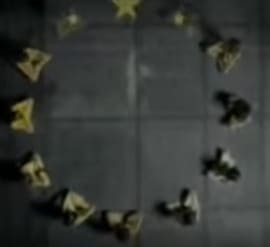Europe: the Final Acts of a Collapsing Empire
Many of us were surprised by what looked like an abrupt reversal of the European Union’s attitude. Up to no long ago, the Union styled itself as peaceful, supporting human rights, and dedicated to the protection of the environment. Then, it suddenly decided to drop all pretenses to be a group of nice people, and to dedicate a large fraction of its remaining resources to preparing for war. Was it unexpected? Not really; the writing was on the walls of the EU buildings in Brussels long before. The clip above was produced by the EU in 2012 with the title, “The More we are, the Stronger we are.” It was recalled almost immediately after it was accused of racism. But it was an ominous sign of things to come.
Years ago, my aunt told me of when she had noticed that something was wrong with her husband, my uncle. One day, she found him in front of the door of their house, unable to push the key into the lock. She helped him unlock the door and get inside, and she didn’t pay too much attention to that strange moment. Maybe her husband was tired, or maybe worried about something. But, less than one year later, he was dead. He spent his last months in a vegetative state in a hospital, while a fast-growing tumor destroyed his brain.

It is a sad story, but that day was a miniature of the behavior of complex systems. Long before they collapse, they leak small warnings—cracks in the wall, receding water on the beach, a metallic knock in the engine. Human beings are complex systems. My uncle was one, and his problem was visible in small things, such as being unable to unlock a door. It is normal; most often, these ominous signs are ignored, or heeded only when it is too late.
Now, consider the European Union. Many of us were startled when we heard of the “Rearm Europe” initiative that would use resources that Europeans desperately need into a useless show of force that risks leading Europe to a major war. What happened to the formerly peaceful Europe? Was it really unexpected? Or were there early hints of future collapse?
Rethinking this story, a hint that something was rotten in the EU was the clip that I am showing to you at the beginning of this post. When it appeared in 2012, I didn’t pay too much attention to it. But revisiting it today, it was a clear message.
Watch the clip. It shows a white woman (Europe) in a yellow jumpsuit, straight from Quentin Tarantino’s “Kill Bill” movie. Three dark-skinned men (China, India, and Africa), appear and perform an aggressive show of martial art skills. The woman watches, then she multiplies herself into a dozen copies, surrounding the three men. Then she vaporizes them into nothingness, while she and her clones become the stars of the European flag.

The director of the EU division (“DG enlargement”) that produced the clip, Stefano Sannino, said that “all characters (were) showing their mutual respect, concluding in a position of peace and harmony.” What peace and harmony? One side surrounded the other and destroyed it. No dialog, no speaking to each other. It feels like the ultimate Brussels bubble moment: well-intentioned but utterly blind to how it reads as Europe asserting dominance over the "other" under the guise of unity.
At the time, most people, including me, thought it the enlargement was a good idea. Few could see that Europe was embarking on a collision course with Russia. But the message of the clip was clear. It was as the EU was subconsciously scripting its own hubris: we'll absorb you, strengthen ourselves, and pretend it is benevolence on our part. And we reserve the right to vaporize you if we wish.
And that was the writing on the wall of the EU Buildings in Brussels. We are seeing the EU moving along a path that all states in history have followed before their collapse. Their last spasms include a desperate attempt to use force to control what cannot be controlled anymore. That is what “Rearm Europe” really is.
But, by now, the collapse of the Union is no longer a question of “if,” but of “when.” A united Europe was a beautiful dream, but it has turned into a nightmare. It will be a rude awakening.
_______________________________________________________________
This is the mail that recalled the clip. Read it, then re-watch the video: the gap between what they thought they made and what we all saw is the exact width of Brussels’ bubble.
Subject: Communication on the clip “The more we are, the stronger we are”
Brussels, 3 January 2012
Dear Member of the European Parliament,
Over the last days we have received a considerable amount of feedback on the short video-clip “The more we are, the stronger we are” that was launched on 21 December 2011 as part of our on-line campaign on EU enlargement.
The clip was conceived as a viral product aimed at young people (16-24) who are familiar with the codes of martial-arts films and video-games. Focus-group testing carried out before release had shown that the target audience understood the story as a metaphor of diversity and strength and reacted positively to it.
The narrative shows three martial-arts masters – respectively practitioners of kung-fu, capoeira and kalaripayattu – demonstrating their skills. A European woman appears, sits down peacefully and multiplies herself, surrounding the fighters. All characters then sit together in a circle, symbolising mutual respect and harmony. The clip ends with the tag-line “The more we are, the stronger we are”, illustrating the idea that the EU grows stronger by welcoming new countries and cultures.
Nevertheless, we note that the clip has been interpreted by many viewers as carrying a racist message, a reading that was never intended. We regret this perception and apologise to anyone who may have felt offended.
Given the controversy, we have decided to withdraw the clip immediately and to stop the campaign.
We remain committed to communicating the enlargement policy in ways that are inclusive and respectful of all cultures.
Yours sincerely,
Stefano Sannino
Director-General
DG Enlargement
European Commission
_______________________________________________________________
Ugo Bardi’s Book — Exterminations




